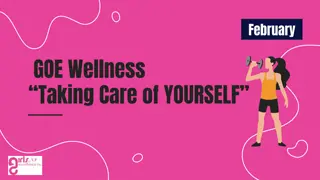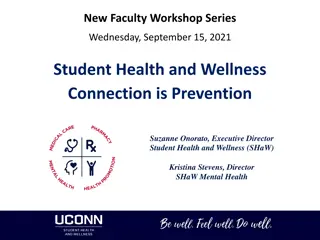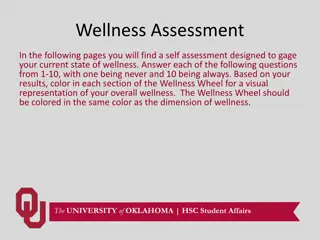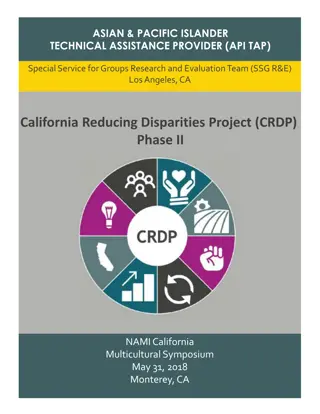
Sustaining Mental Wellness in Social Work: Burnout & Compassion Fatigue
Explore the impact of burnout, compassion fatigue, and vicarious trauma on social workers in rural and remote settings. Learn strategies to mitigate these challenges and promote mental well-being.
Uploaded on | 2 Views
Download Presentation

Please find below an Image/Link to download the presentation.
The content on the website is provided AS IS for your information and personal use only. It may not be sold, licensed, or shared on other websites without obtaining consent from the author. If you encounter any issues during the download, it is possible that the publisher has removed the file from their server.
You are allowed to download the files provided on this website for personal or commercial use, subject to the condition that they are used lawfully. All files are the property of their respective owners.
The content on the website is provided AS IS for your information and personal use only. It may not be sold, licensed, or shared on other websites without obtaining consent from the author.
E N D
Presentation Transcript
Chapter 7: Sustaining Our Own Mental Wellness: A Reflection on Burnout, Vicarious Trauma, and Compassion Fatigue in a Rural and Remote Social Work Context Melanie Abbott
Introduction This chapter will discuss: What the terms burnout , compassion fatigue , and vicarious trauma mean. How social workers are impacted by the work we do, both by the impacts of the job itself and the organization we work for, as well as how we cope with the trauma of others. How the mental health impacts may vary between social workers on urban vs rural/remote settings.
Learning Objectives By the end of this chapter you will have had the opportunity to: Learn about the concepts of burnout, compassion fatigue, and vicarious trauma. Explore some of the unique challenges of living and working in rural and remote locations. Understand why location matters by exploring some of the unique factors contributing to mental wellness or un-wellness among social workers in rural and remote settings versus urban ones. Recognize some ways that we, as social workers, can mitigate some of the above symptoms and promote our own mental wellness so we can be present with our clients, but also have an improved quality of life outside work.
Practice Area and/or the Population of Focus Social workers working in rural/remote communities Social workers, know that individuals need to have balance to be healthy. If we are not careful, we may start to put more energy into work and our clients than we are putting into our personal lives, leaving our wellness unbalanced. Whether the overload is coming from job- or client-related factors, the impact on us will look different.
Overview of Policy and Service Delivery Issues Burnout Burnout relates to organizational factors as opposed to the effects of working with a particular clientele. These are often connected to our lack of ability to effect change due to organizational limitations. Burnout presents itself in three overarching symptom clusters, or dimensions: exhaustion, cynicism, and ineffectiveness (Maslach & Leiter, 1997). Social workers have the potential to become impacted by organizational stress or through the experiences of their clients.
Overview of Policy and Service Delivery Issues Compassion Fatigue Compassion fatigue is how much care we give to others at the expense of ourselves and involves the professional themselves experiencing symptoms of trauma. Symptoms of trauma may include emotions of fear or anger, physical reactions of having a strong startle response ( jumpy ) and muscle tension, sleep disturbances, flashbacks, nightmares, and cognitive distortions also can be part of the experience. Acknowledging that empathy and compassion are cornerstone to a helping professional but that with this comes risk to the helper themselves.
Overview of Policy and Service Delivery Issues Vicarious Trauma Vicarious trauma is similar to compassion fatigue in that it evolves from secondary exposure to trauma through our clients experiences; however, unlike compassion fatigue it involves a change in the helper s worldview and may or may not include trauma symptomology. Beyond the experience of compassion fatigue, vicarious trauma changes how an affected person views the world. This points to the intensity of the work we do as professionals in the business of working with society s most vulnerable.
3 Levels of Social Work Practice Micro Interpersonal dynamics between social workers and their clientele with different cultures/backgrounds/lived experiences and how the social worker is perceived can cause misunderstandings leading to stress and the various types of trauma discussed in this chapter. Lack of support/resources/opportunities, high workload contribute to burnout. Direct client contact is needed for compassion fatigue and vicarious trauma to occur.
3 Levels of Social Work Practice Mezzo Social workers in rural or remote communities may have a more challenging experience than their urban counterparts when trying to protect client confidentiality as well as their own sense of privacy since opportunities for recreation and other community engagement are limited.
3 Levels of Social Work Practice Macro Burnout is attributed to organizational factors, including policies, many of which take time to change. We know the long-standing history of the trauma that Indigenous people have experienced in Canada and the inter- generational effects today. Social factors can also contribute to some of the negative impacts on a social worker s mental health, whether that be cultural norms or socio-economic influences such as high rates of poverty or homelessness.
Conclusion There are some factors between rural and urban settings that are different for social workers, including the impact on their mental health Taking control where you can might help alleviate some of the mental health impacts, including finding a balance between work and personal life
Additional Resources McCann, L., & Pearlman, L. A. (1990). Vicarious traumatization: A framework for understanding the psychological effects of working with victims. Journal of Traumatic Stress, 3(1), 131-149. Maslach, C., Schaufeli, W. B., & Leiter, M. P. (2001). Job burnout. Annual review of Psychology, 52, 397-422. Maslach, C., Jackson, S. E., & Leiter, M. P. (1996). Maslach Burnout Inventory (3rd ed.). Consulting Psychologists Press. Valent, P. (2007). Eight survival strategies in traumatic stress. Traumatology, 13, 4-14. Van Dernoot Lipsky, L., & Burk, C. (2009). Trauma stewardship: An everyday guide to caring for self while caring for others. Berrett-Koehler Publishers, Inc.
References Maslach, C., & Leiter, M. P. (1997). The truth about burnout: How organizations cause personal stress and what to do about it. Jossey-Bass Inc.






















